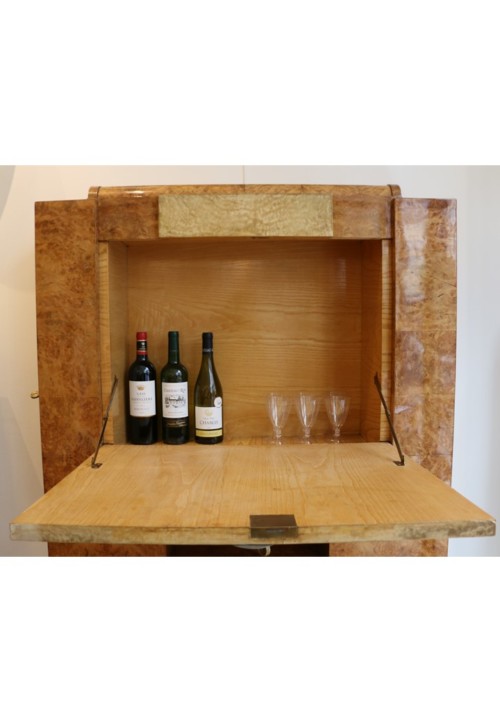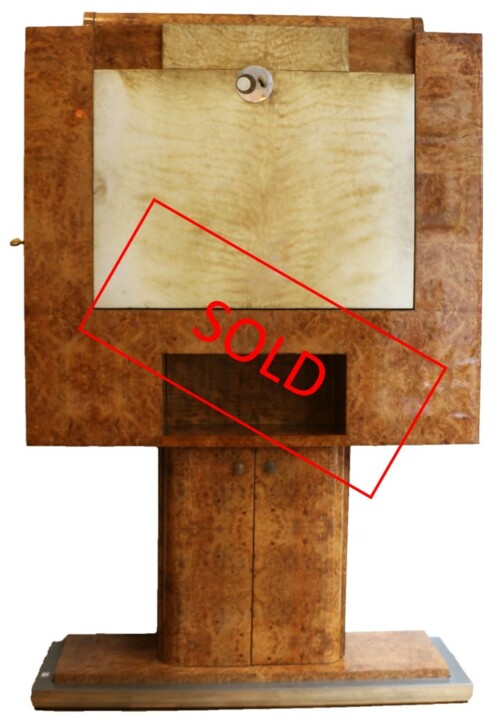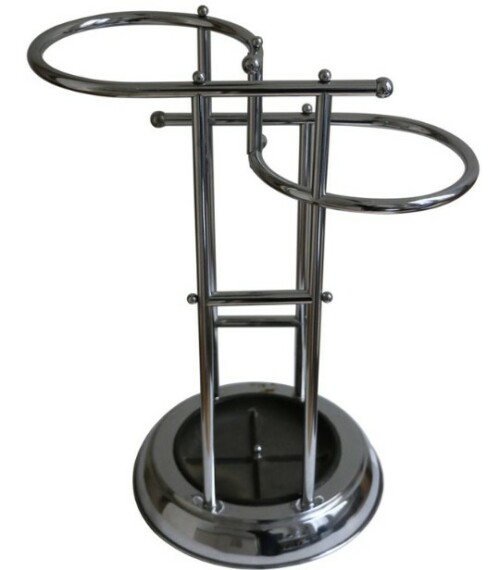- Terre cuite, XIV-XV siècle (test de thermoluminescence : Interexpert 388317 du 18 mars 1988).
- Motifs Koma-Bulsa (Ghana), notamment la coiffure cocave avec ornements frontaux tressés, le collier chiik en demi-lune semblable à celui que portent les Bulsa aujourd’hui, le poignard inséré dans une lanière ornementale portée à l’l’épaule gauche.
-
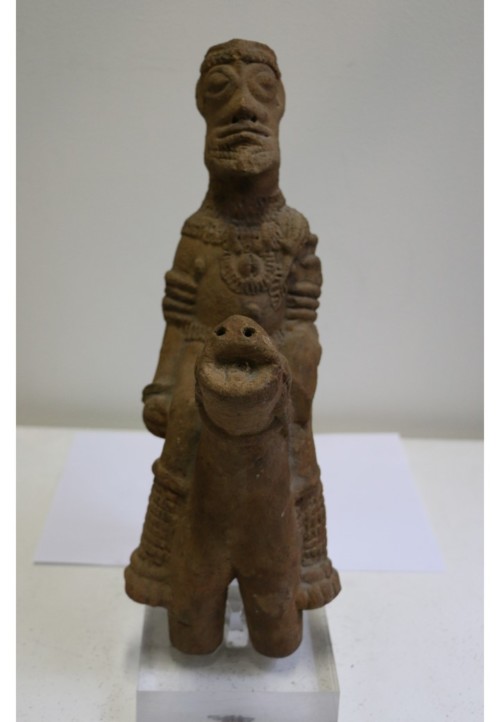
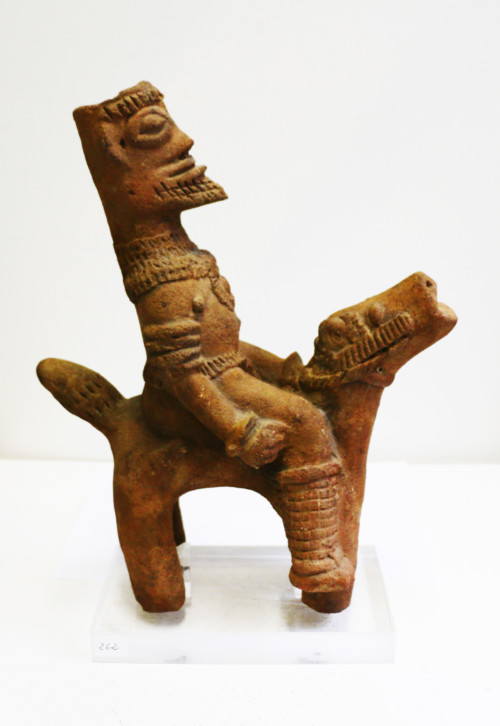 Dimensions H : 33,5 cm W : 26 cm D : 13 cm/H : 13.19 in W : 10.24 in D : 5.12 in
Dimensions H : 33,5 cm W : 26 cm D : 13 cm/H : 13.19 in W : 10.24 in D : 5.12 in -
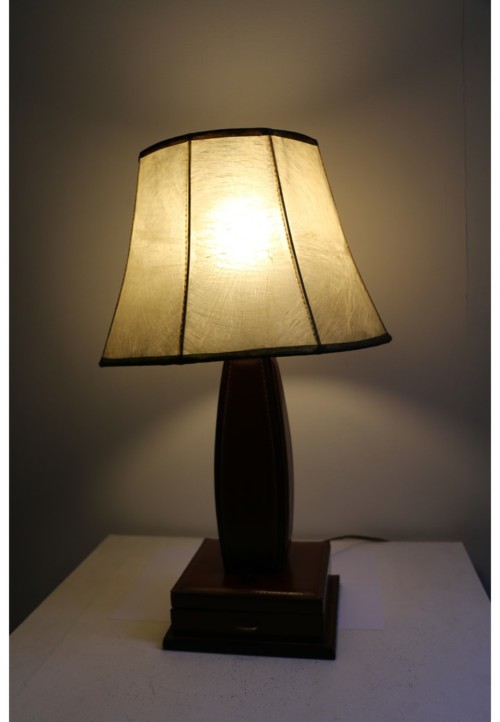
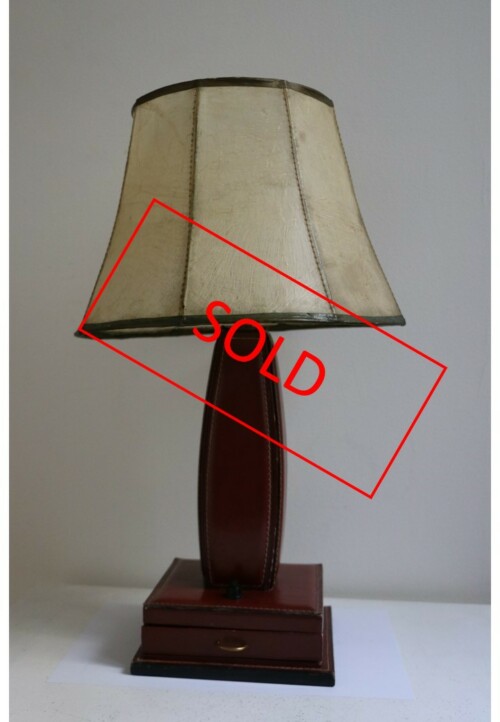 Jacques ADNET (1900-1984) Lampe de table à structure en bois, gainée de cuir rouge à piqûres sellier, à base carrée ouvrant sur un petit tiroir à poignée en laiton doré, abat-jour d’origine en fibre de verre projeté sur armature métal Années 50 Pied : H : 33 cm ; L : 17 cm ; P : 17 cm Abat-jour : H : 21 cm ; D : 30 cm Hauteur totale : 50 cm Pour plus d’informations sur le créateur, cliquer sur le nom : Jacques ADNET
Jacques ADNET (1900-1984) Lampe de table à structure en bois, gainée de cuir rouge à piqûres sellier, à base carrée ouvrant sur un petit tiroir à poignée en laiton doré, abat-jour d’origine en fibre de verre projeté sur armature métal Années 50 Pied : H : 33 cm ; L : 17 cm ; P : 17 cm Abat-jour : H : 21 cm ; D : 30 cm Hauteur totale : 50 cm Pour plus d’informations sur le créateur, cliquer sur le nom : Jacques ADNET -
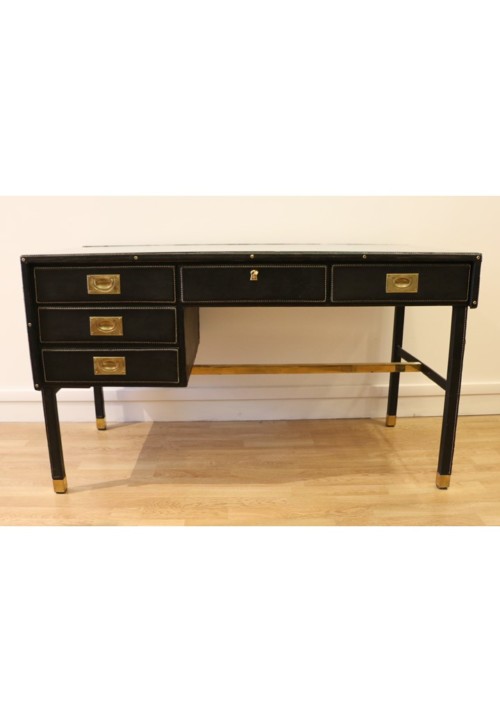
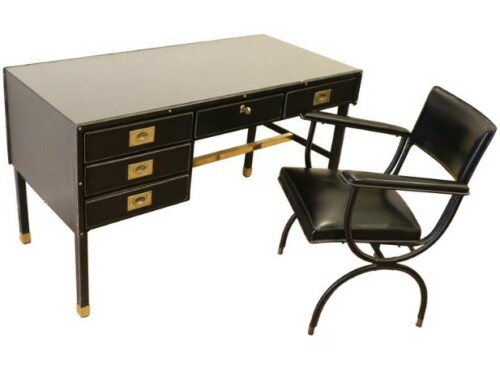 Jacques ADNET (1900-1984) Bureau et son fauteuil Recouverts skaï et cuir piqué sellier. Poignées bateau et sabots en laiton Années 50 H : 77,5 cm ; L : 131 cm ; P : 61,5 cm Pour plus d’informations sur le créateur, cliquer sur le nom : Jacques ADNET
Jacques ADNET (1900-1984) Bureau et son fauteuil Recouverts skaï et cuir piqué sellier. Poignées bateau et sabots en laiton Années 50 H : 77,5 cm ; L : 131 cm ; P : 61,5 cm Pour plus d’informations sur le créateur, cliquer sur le nom : Jacques ADNET
Desk and armchair Covered in skai and saddle-stitched leather. Boat handles and brass shoes. 1950's H: 77.5 cm; W: 131 cm; D: 61.5 cm For more informations : : Jacques ADNET -

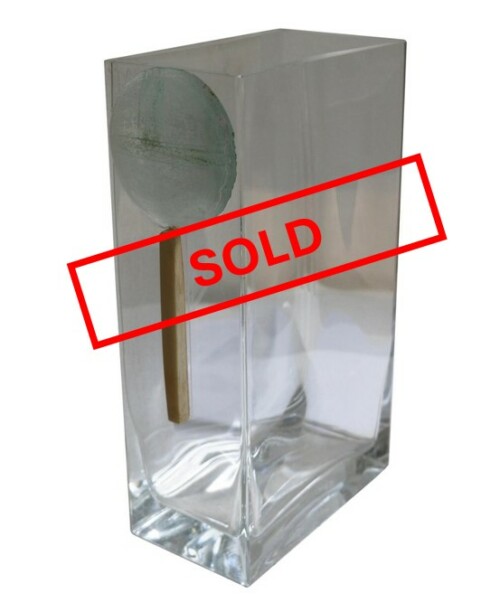 A. Riecke — Vase Art-Déco Vase Art-Déco gravé d’un décor cubisant. Signé et daté 4.8.39. H : 27 cm ; L : 15 cm ; P : 8,5 cm A. Riecke, artiste russe, installé à Paris a été responsable du décor en verrerie Art Déco de 1930 à 1937 du restaurant La Coupole à Paris. Le Restaurant La Coupole est le temple de l’Art Déco. Il naît en 1927 de la volonté de deux Auvergnats, Ernest Fraux et René Lafon. Le soir de l’inauguration, tout le monde des Arts, des Lettres, de la nuit est là : des artistes et leurs modèles, des mondains et des flambeurs.
A. Riecke — Vase Art-Déco Vase Art-Déco gravé d’un décor cubisant. Signé et daté 4.8.39. H : 27 cm ; L : 15 cm ; P : 8,5 cm A. Riecke, artiste russe, installé à Paris a été responsable du décor en verrerie Art Déco de 1930 à 1937 du restaurant La Coupole à Paris. Le Restaurant La Coupole est le temple de l’Art Déco. Il naît en 1927 de la volonté de deux Auvergnats, Ernest Fraux et René Lafon. Le soir de l’inauguration, tout le monde des Arts, des Lettres, de la nuit est là : des artistes et leurs modèles, des mondains et des flambeurs. -
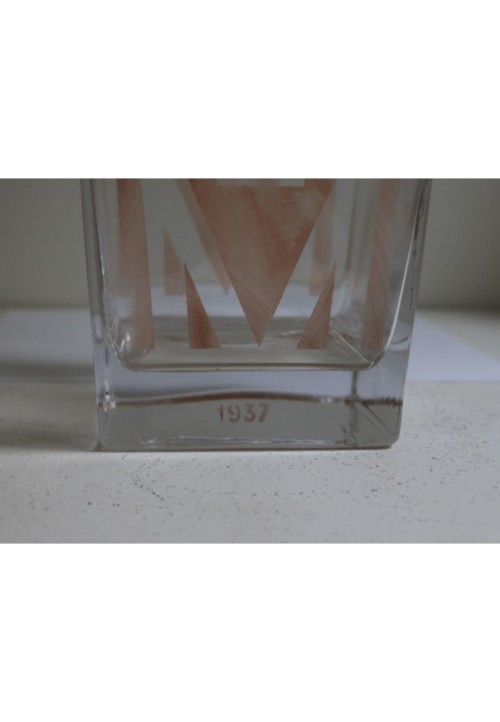
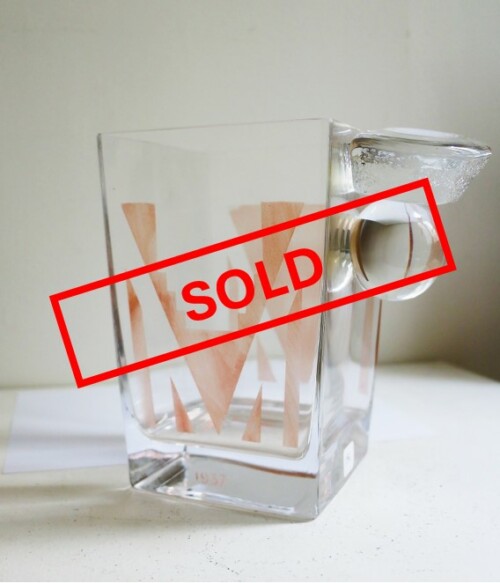 A. Riecke — Vase Art-Déco Vase Art-Déco gravé d’un décor cubisant et daté 1937. Provenance : restaurant La Coupole à Paris. H : 20 cm ; L : 20 cm ; P : 13 cm A. Riecke, artiste russe, installé à Paris a été responsable du décor en verrerie Art Déco de 1930 à 1937 du restaurant La Coupole à Paris. Le Restaurant La Coupole est le temple de l’Art Déco. Il naît en 1927 de la volonté de deux Auvergnats, Ernest Fraux et René Lafon. Le soir de l’inauguration, tout le monde des Arts, des Lettres, de la nuit est là : des artistes et leurs modèles, des mondains et des flambeurs.
A. Riecke — Vase Art-Déco Vase Art-Déco gravé d’un décor cubisant et daté 1937. Provenance : restaurant La Coupole à Paris. H : 20 cm ; L : 20 cm ; P : 13 cm A. Riecke, artiste russe, installé à Paris a été responsable du décor en verrerie Art Déco de 1930 à 1937 du restaurant La Coupole à Paris. Le Restaurant La Coupole est le temple de l’Art Déco. Il naît en 1927 de la volonté de deux Auvergnats, Ernest Fraux et René Lafon. Le soir de l’inauguration, tout le monde des Arts, des Lettres, de la nuit est là : des artistes et leurs modèles, des mondains et des flambeurs. -
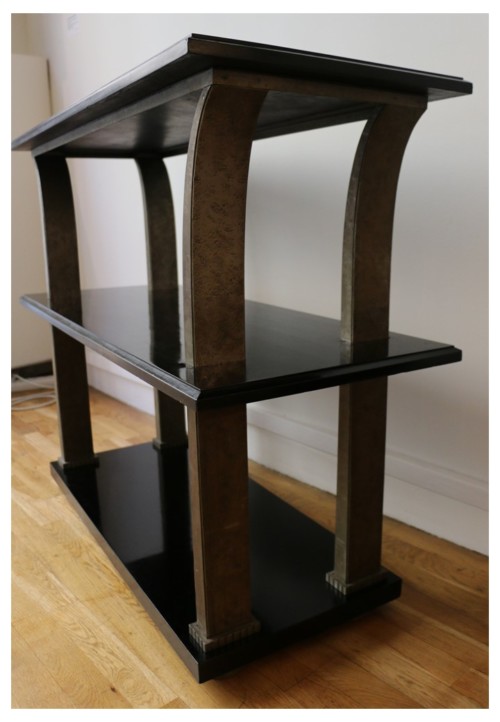
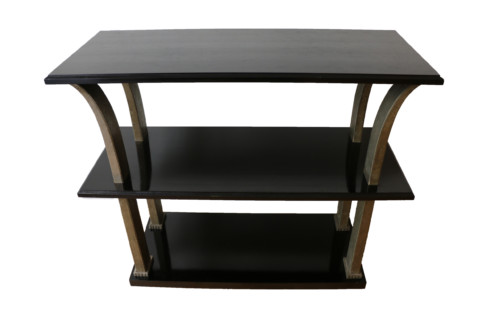 Edgar BRANDT(1880-1960) Console à trois plateaux rectangulaires en bois relaqué noir. Piétement d'angle à quatre jambes quadrangulaires fuselées en métal à corps stylisant des palmes, bagues rainurées en partie basse. Cette console est symétrique, ne nécessite pas d'être adossée contre un mur et peut être utilisée comme table de milieu. Frappé de l'estampille sur un des pieds. Années 1920 H : 90 cm ; L : 108 cm ; Profondeur : 45 cm Pour plus d’informations sur le créateur, cliquer sur le nom : Edgar BRANDT
Edgar BRANDT(1880-1960) Console à trois plateaux rectangulaires en bois relaqué noir. Piétement d'angle à quatre jambes quadrangulaires fuselées en métal à corps stylisant des palmes, bagues rainurées en partie basse. Cette console est symétrique, ne nécessite pas d'être adossée contre un mur et peut être utilisée comme table de milieu. Frappé de l'estampille sur un des pieds. Années 1920 H : 90 cm ; L : 108 cm ; Profondeur : 45 cm Pour plus d’informations sur le créateur, cliquer sur le nom : Edgar BRANDT
Stunning Metal and Wood Console by Edgar Brandt, Art Deco, France, 1920'sConsole with 3 shelves/trays by Edgar BRANDT(1880-1960). The shelves are made of black relacquered wood. The 4 squared legs are made of hammered metal in a palm shape. Stamped on a leg: "E. Brandt". France, 1920's Dimensions: H : 90 cm ; W : 108 cm ; D : 45 cm The console is fully symetrical so it does not need to be put against a wall and can be displayed in the middle of a room as a center table.For more informations : Edgar BRANDT -
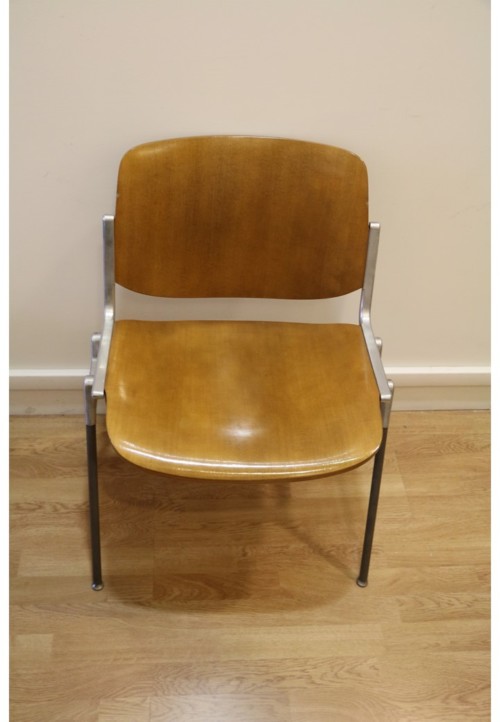
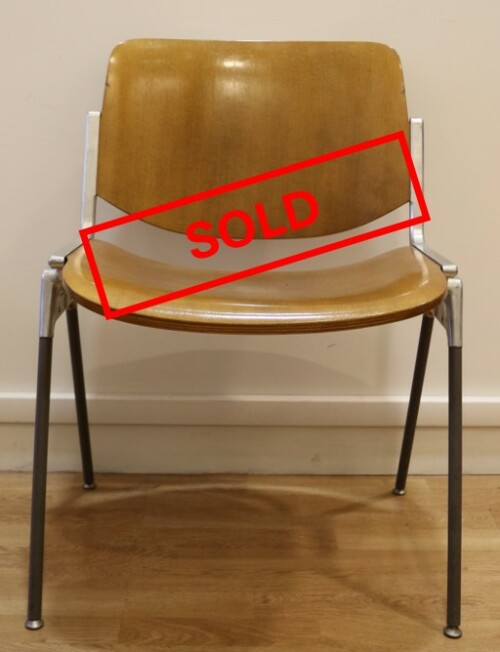 Giancarlo PIRETTI (1940-…) Edition Castelli. Suite de 6 chaises, modèle 106 dessiné en 1967. Assise et dossier en contreplaqué moulé, piètement quadripode tubulaire, gainé avec sabots. Plus édité. Couleur miel clair H : 77 cm ; H d'assise : 48 cm ; L : 56 cm ; P : 48 cm Pour plus d’informations sur le créateur, cliquer sur le nom : Giancarlo PIRETTI
Giancarlo PIRETTI (1940-…) Edition Castelli. Suite de 6 chaises, modèle 106 dessiné en 1967. Assise et dossier en contreplaqué moulé, piètement quadripode tubulaire, gainé avec sabots. Plus édité. Couleur miel clair H : 77 cm ; H d'assise : 48 cm ; L : 56 cm ; P : 48 cm Pour plus d’informations sur le créateur, cliquer sur le nom : Giancarlo PIRETTI
Set of Six Mid-Century Modern Chairs by Giancarlo Piretti, Italy, 1970s. Set of six chairs by Giancarlo Piretti, Model Nr 106 designed in 1967, Italy, Castelli edition. This model is no longer manufactured. Chair back and chair seat made of thermoformed/molded plywood. Veneer has been restored, Very nice light honey color. Legs and frame made of steel and aluminium. These chairs are very comfortable and can be stacked. Another set of two identical chairs is available with a slightly darker veneer. Measures: H 77 cm; Seating H 48 cm; L 56 cm; P 48 cm. For more informations : Giancarlo PIRETTI -
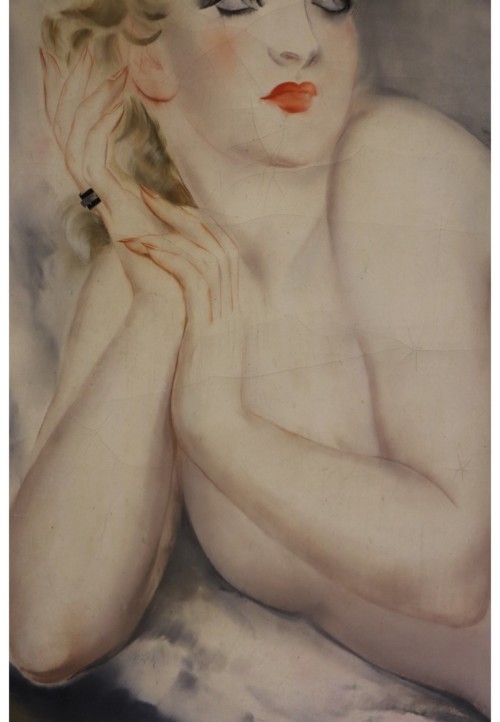
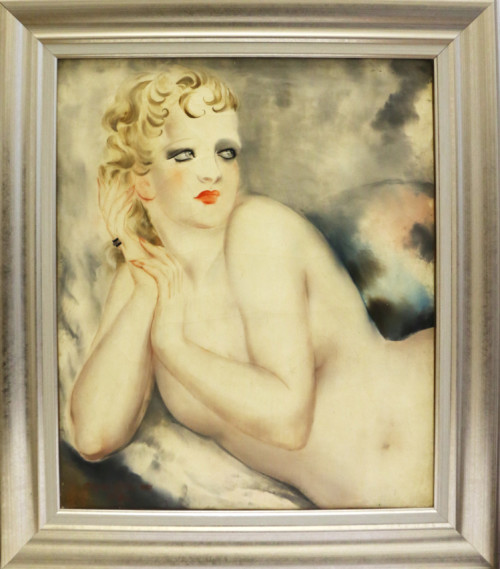 Miçao Kono était un artiste japonais arrivé à Paris au début des années 1920. Il peignait à l'huile et à l'aquarelle, et réalisa également plusieurs gravures. Miçao Kono a devenu célèbre pour ses portraits de nus combinant le style traditionnel japonais à la modernité de l'Art Déco. Ses peintures étaient très populaires dans les intérieurs Art Déco. Romantiques et sensuelles, ses œuvres sont proches de celles de son compatriote japonais Foujita. La technique de Kono était inhabituelle, car il mélangeait le blanc d'œuf avec les pigments de couleur. Soit par intention, soit avec le temps, ses peintures présentent des signes de craquelures.
Miçao Kono était un artiste japonais arrivé à Paris au début des années 1920. Il peignait à l'huile et à l'aquarelle, et réalisa également plusieurs gravures. Miçao Kono a devenu célèbre pour ses portraits de nus combinant le style traditionnel japonais à la modernité de l'Art Déco. Ses peintures étaient très populaires dans les intérieurs Art Déco. Romantiques et sensuelles, ses œuvres sont proches de celles de son compatriote japonais Foujita. La technique de Kono était inhabituelle, car il mélangeait le blanc d'œuf avec les pigments de couleur. Soit par intention, soit avec le temps, ses peintures présentent des signes de craquelures.- Huile sur papier marouflé sur toile.
- Signé et daté 19 (33) en rouge en bas à gauche.
Miçao Kono was a Japanese artist who came to Paris in the early 1920s. He painted in oils and watercolors, and also did a number of etchings. Micao Kono became famous with his nude portraits combining traditional Japanese style with the modernity of the Art Deco. His paintings were very popular in the Art Deco interiors. They were romantic and sensuous; his work is close to his Japanese fellow countryman Foujita. Kono’s technique was unusual as he used to mix egg white with color pigment. Either by design or by the passage of time his paintings show signs of cracking.- Oil on paper pasted on canvas.
- Signed and dated 19 (33) in red at bottom left.
-
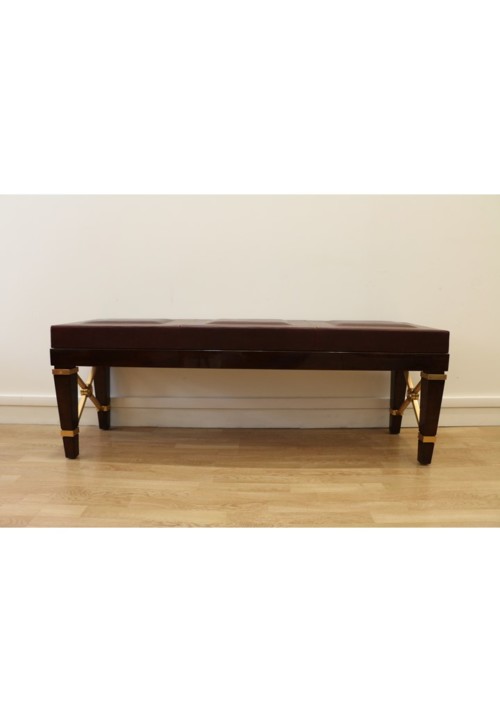
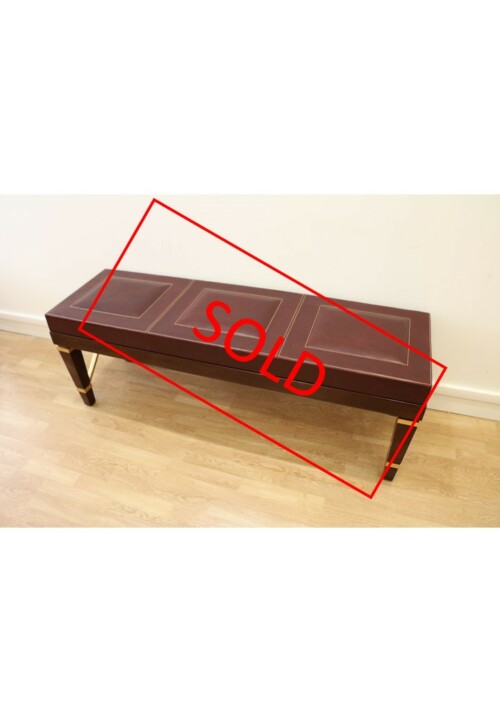 Raymond SUBES (1891-1970) Banquette garnie à neuf d’un cuir brun-rouge à piqûres sellier. Sur pieds gaines en acajou à motifs latéraux croisées en bronze doré. Modèle réalisé pour la Banque de France. La galerie propose deux modèles identiques. Années 1940-1950 Dimensions : H : 54 cm ; L : 150 cm ; P : 45 cm Pour plus d'informations sur le créateur, cliquer sur le nom : Raymond SUBES
Raymond SUBES (1891-1970) Banquette garnie à neuf d’un cuir brun-rouge à piqûres sellier. Sur pieds gaines en acajou à motifs latéraux croisées en bronze doré. Modèle réalisé pour la Banque de France. La galerie propose deux modèles identiques. Années 1940-1950 Dimensions : H : 54 cm ; L : 150 cm ; P : 45 cm Pour plus d'informations sur le créateur, cliquer sur le nom : Raymond SUBES
Bench by Raymond Subes (1891-1970) from the years 1940s-1950s The legs are made of mahogany with lateral X shape gilt bronze design, it is covered with red-brown saddle-stitched leather. It is fully restored (new leather and varnish) and is in perfect condition. This bench was created by R Subes for the Banque de France (French State Bank). The gallery has in stock another identical item. Raymond Subes is one of the major designers of the 1920s to the 1940. He collaborated with many famous architects and artists of his time e.g. steamers decoration and major exhibitions such as the Exposition Internationale des Arts Décoratifs in 1925 which set the Art Deco style on the world stage and the Exposition Universelle de Paris in 1937. His iron work made him famous and he is with Poillerat and Arbus one of the greatest designers of the 1940s style. In 1958 he was elected a member of the French Académie des Beaux-arts. -

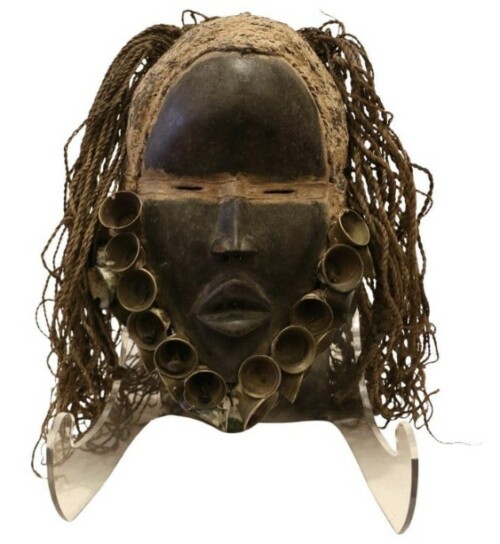 Les Dan, sous-tribu des Dan-Nguere, vivent à l'est du Liberia, en Guinée Conakry et en Côte d'Ivoire. Leur structure sociale et spirituelle repose sur la société secrète Poro, signifiant "sierra" en langue temné. La distinction entre Guéré et Wobé n'existait pas avant la colonisation. Dans la tradition orale, ces deux groupes formaient une seule population appelée Wé. La différenciation a été introduite par l'administration coloniale. Les masques Dan-Nguere, variés et utilisés à des fins diverses selon les régions, se divisent en deux types principaux. Les masques féminins valorisent la beauté du visage avec des traits délicats et une patine brillante. Ils servent à régler les conflits et à protéger les nouveau-nés. Les masques masculins, plus réalistes et parfois ornés de détails animaliers, incarnent la force vitale "du", envoyée par le créateur Zlan. Ces masques sont vénérés et utilisés pour protéger contre les maladies, présidant divers événements sociaux et spirituels, témoignant de l'importance des masques dans la culture Dan.
Les Dan, sous-tribu des Dan-Nguere, vivent à l'est du Liberia, en Guinée Conakry et en Côte d'Ivoire. Leur structure sociale et spirituelle repose sur la société secrète Poro, signifiant "sierra" en langue temné. La distinction entre Guéré et Wobé n'existait pas avant la colonisation. Dans la tradition orale, ces deux groupes formaient une seule population appelée Wé. La différenciation a été introduite par l'administration coloniale. Les masques Dan-Nguere, variés et utilisés à des fins diverses selon les régions, se divisent en deux types principaux. Les masques féminins valorisent la beauté du visage avec des traits délicats et une patine brillante. Ils servent à régler les conflits et à protéger les nouveau-nés. Les masques masculins, plus réalistes et parfois ornés de détails animaliers, incarnent la force vitale "du", envoyée par le créateur Zlan. Ces masques sont vénérés et utilisés pour protéger contre les maladies, présidant divers événements sociaux et spirituels, témoignant de l'importance des masques dans la culture Dan.- Côte d'Ivoire.
- Bois, patine d'usage noire, pigments, nombreuses clochettes en bronze, fibres végétales.
- Première moitié du XXème siècle.
The Dan, a sub-tribe of the Dan-Nguere, inhabit eastern Liberia, Guinea Conakry, and Côte d'Ivoire. Their social and spiritual structure is based on the secret society Poro, which means "sierra" in the Temne language. The distinction between Guéré and Wobé did not exist before colonization. In oral tradition, these two groups formed a single population called Wé. This differentiation was introduced by colonial administration. Dan-Nguere masks are diverse and used for various purposes depending on the region. They can be divided into two main types. Female masks emphasize the beauty of the face with delicate features and a shiny patina. They serve to resolve conflicts and protect newborns. Male masks, more realistic and sometimes adorned with animal details, embody the vital force "du," sent by the creator Zlan. These masks are venerated and used for protection against illnesses, presiding over various social and spiritual events, highlighting the significance of masks in Dan culture.- Côte d'Ivoire.
- Wood, black usage patina, pigments, numerous bronze bells, plant fibers.
- First half of the 20th century.
-
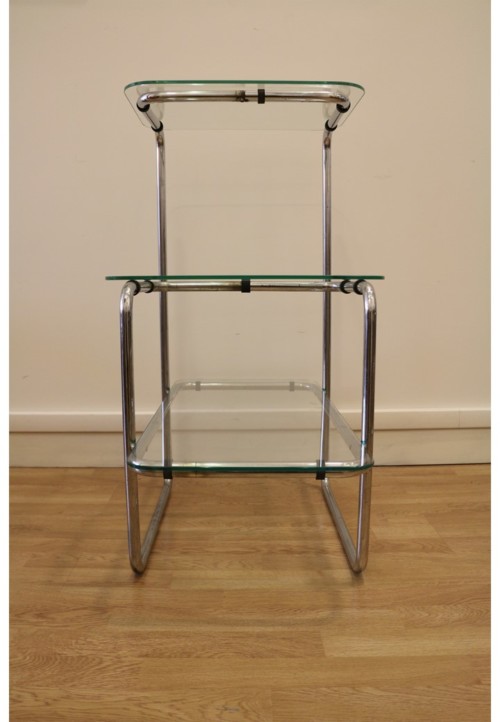
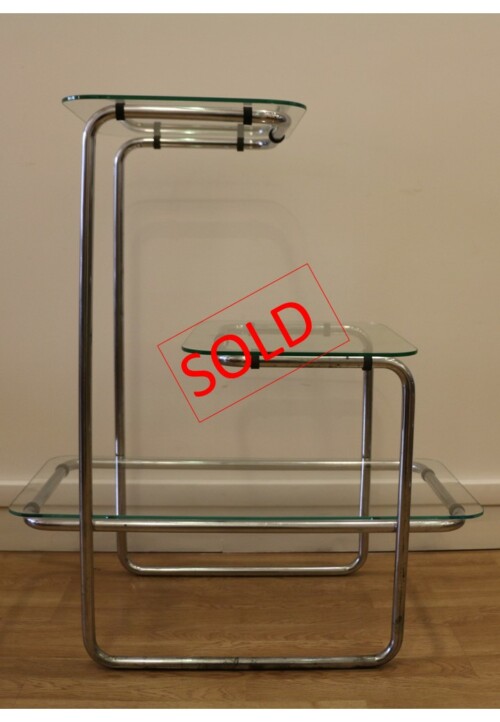 Emile GUILLOT Etagères à trois niveaux Modèle B136 Trois plateaux de verre sur châssis tubulaire chromé. Vers 1930 H : 86 cm ; L : 74 cm ; P : 45 cm
Emile GUILLOT Etagères à trois niveaux Modèle B136 Trois plateaux de verre sur châssis tubulaire chromé. Vers 1930 H : 86 cm ; L : 74 cm ; P : 45 cm
Shelves by Emile Guillot, circa 1930. Shelves with three levels and three glass on chromium tubular frame.Dimensions :H : 33.86 in. ; W : 29.13 in. ; D : 17.72 in.H : 86 cm ; W : 74 cm ; D : 45 cm -
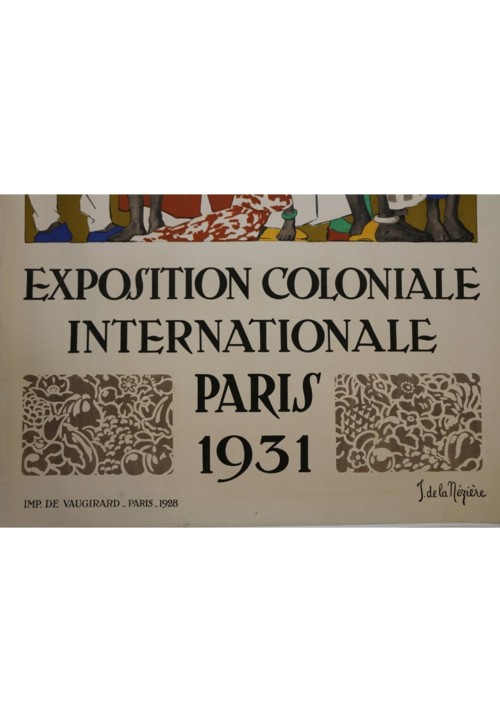
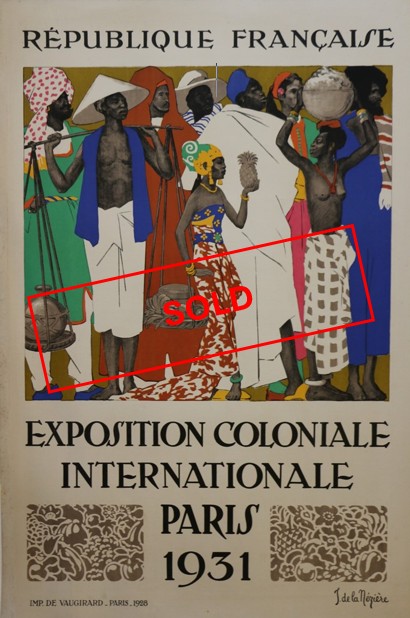 AVIS : En vendant cette œuvre, nous ne soutenons pas le concept de colonialisme. Malheureusement, le colonialisme fait partie intégrante de l'histoire et est devenu un thème majeur dans l'art de cette époque. Cette belle image ne contient pas de connotation raciste, que ce soit de manière visible ou à la lumière de l'histoire de l'artiste. Joseph Daviel de La Nézière était un peintre et illustrateur français qui a travaillé avec le ministère des Colonies. Il a fait sa première exposition au Salon de la Société Nationale des Beaux-Arts en 1897. Il a voyagé largement, créant des croquis et des peintures inspirés par des pays comme l'Italie, le Sénégal et le Japon. En 1919, il a contribué à revivre l'artisanat local au Maroc, produisant plus de 300 tapis. Il a également conçu des panneaux décoratifs pour le paquebot Normandie et a participé à l'Exposition universelle de 1939-1940 à New York. La Nézière est décédé à Casablanca le 15 avril 1944 et est enterré au cimetière de Passy à Paris.
AVIS : En vendant cette œuvre, nous ne soutenons pas le concept de colonialisme. Malheureusement, le colonialisme fait partie intégrante de l'histoire et est devenu un thème majeur dans l'art de cette époque. Cette belle image ne contient pas de connotation raciste, que ce soit de manière visible ou à la lumière de l'histoire de l'artiste. Joseph Daviel de La Nézière était un peintre et illustrateur français qui a travaillé avec le ministère des Colonies. Il a fait sa première exposition au Salon de la Société Nationale des Beaux-Arts en 1897. Il a voyagé largement, créant des croquis et des peintures inspirés par des pays comme l'Italie, le Sénégal et le Japon. En 1919, il a contribué à revivre l'artisanat local au Maroc, produisant plus de 300 tapis. Il a également conçu des panneaux décoratifs pour le paquebot Normandie et a participé à l'Exposition universelle de 1939-1940 à New York. La Nézière est décédé à Casablanca le 15 avril 1944 et est enterré au cimetière de Passy à Paris.- Affiche lithographique de l'Exposition Coloniale Internationale de Paris de 1931.
- Imprimée par De Vaugirard, Paris.
DISCLAIMER: In selling this piece, we do not support the concept of colonialism. Unfortunately, colonialism is a significant part of history and has become a prominent theme in the art of that era. This beautifully executed image does not contain any racist connotations, either visibly or in light of the artist's history. Joseph Daviel de La Nézière was a French painter and illustrator who worked with the Ministry of Colonies. He first exhibited at the Salon of the Société Nationale des Beaux-Arts in 1897. He traveled extensively, creating sketches and paintings inspired by countries like Italy, Senegal, and Japan. In 1919, he helped revive local craftsmanship in Morocco, producing over 300 carpets. He also designed decorative panels for the ocean liner Normandie and participated in the 1939-1940 World's Fair in New York. La Nézière passed away in Casablanca on April 15, 1944, and is buried in Passy Cemetery, Paris.- Lithographic poster for the International Colonial Exhibition of Paris, from 1931.
- Printed by De Vaugirard, Paris.
DimensionsH : 120.5 cm W : 80.5 cm/H: 47.44 in W: 31.69 inFor more information : Joseph de la NEZIERE -

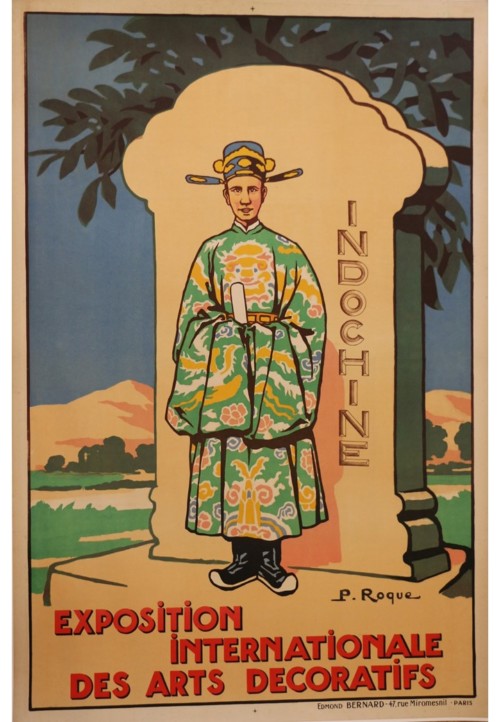
- Affiche lithographique de l'Exposition Internationale des Arts Décoratifs de 1925.
- Imprimée par Edmond Bernard, Paris.
- Lithographic poster for the International Exhibition of Decorative Arts, 1925.
- Printed by Edmond Bernard, Paris.
Dimensions H : 121,2 cm L : 80,4 cm/H: 47.72 in W: 31.65 in -
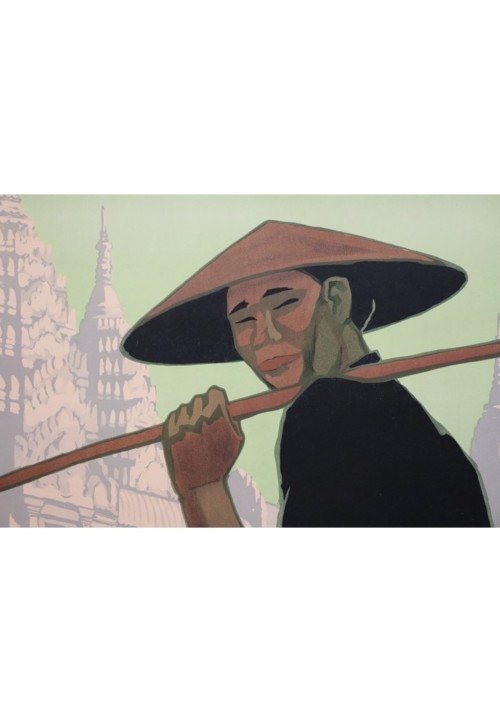
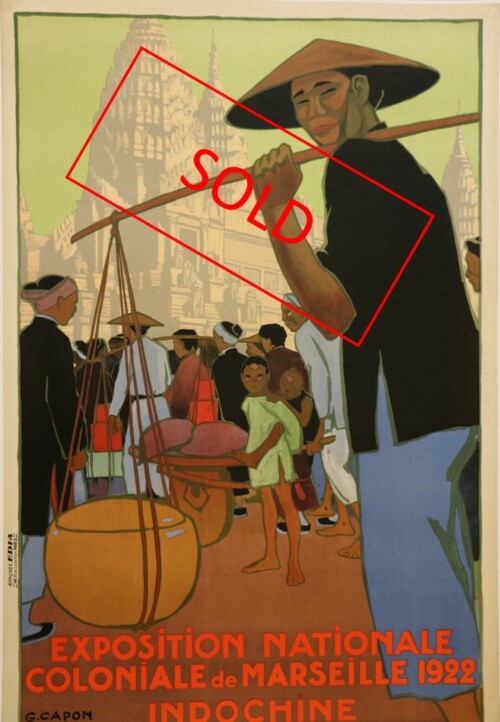 Georges CAPON (1890-1980) Affiche lithographique non entoilée de l'Exposition Coloniale de Marseille de 1922. Indochine. Imprimée par Edia. Très bon état, marges légèrement froissées, couleurs vives et fraîches. Dimensions : H : 120,8 cm; L : 80,4 cm
Georges CAPON (1890-1980) Affiche lithographique non entoilée de l'Exposition Coloniale de Marseille de 1922. Indochine. Imprimée par Edia. Très bon état, marges légèrement froissées, couleurs vives et fraîches. Dimensions : H : 120,8 cm; L : 80,4 cm
National Colonial Exhibition of Marseille, by Georges Capon (1890-1980) Lithographic poster for the National Colonial Exhibition of Marseille, from 1922. Printed by Edia. Very good state, slightly creased margins, bright and fresh colours.Dimensions :H : 120,8 cm ; W : 80,4 cm -
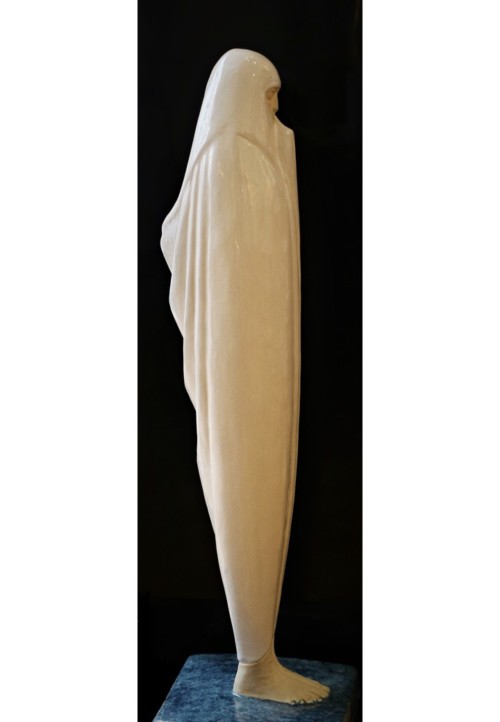
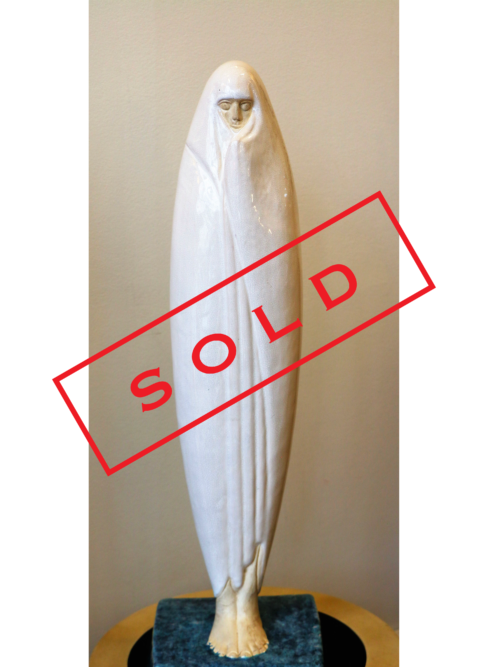 Céline LEPAGE (1882-1928) "Femme voilée de Marrakech", céramique à glaçure craquelée blanche, sur un socle bleu. Marque en creux "CL". Vers 1920-1925 Dimensions : H : 74 cm Pour plus d’informations sur le créateur, cliquer sur le nom : Céline LEPAGE
Céline LEPAGE (1882-1928) "Femme voilée de Marrakech", céramique à glaçure craquelée blanche, sur un socle bleu. Marque en creux "CL". Vers 1920-1925 Dimensions : H : 74 cm Pour plus d’informations sur le créateur, cliquer sur le nom : Céline LEPAGE
"Veiled woman of Marrakesh", by Céline Lepage (1882-1928) Ceramic sculpture of a veiled woman, with a crazed glaze, standing on a blue base. Mark in counter-relief on the base : "CL". Around 1920-1925Dimensions :H : 29.13 in.H : 74 cmFor more information : Céline LEPAGE -
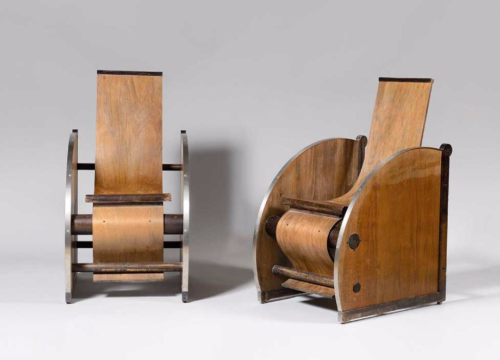
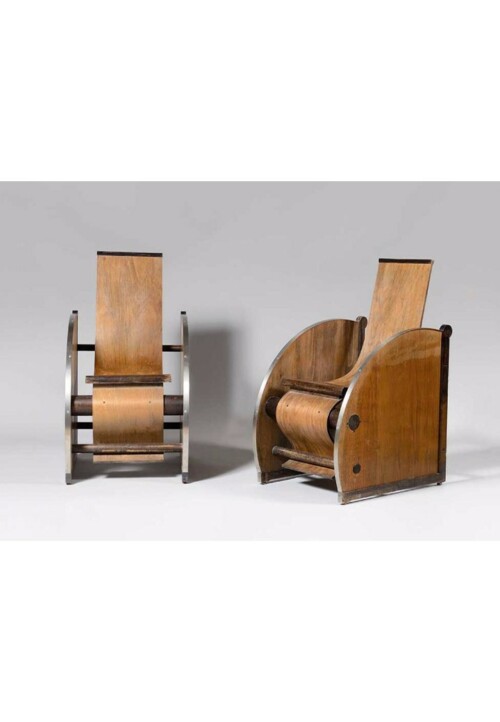 Paire de fauteuils, travail moderniste Paire de fauteuils en bois et métal chromé, avec assise en contreplaqué, moulé entre deux montants arrondis pleins. Ces fauteuils proviennent d'un club d'hommes d'affaires de la région de Longwy. Circa 1925. Dimensions : H : 98 cm; L : 65 cm ; Prof. : 54 cm
Paire de fauteuils, travail moderniste Paire de fauteuils en bois et métal chromé, avec assise en contreplaqué, moulé entre deux montants arrondis pleins. Ces fauteuils proviennent d'un club d'hommes d'affaires de la région de Longwy. Circa 1925. Dimensions : H : 98 cm; L : 65 cm ; Prof. : 54 cm
Pair of modernist armchairs Pair of modernist armchairs made from wood and chrome-plated metal, with a plywood seat, between two rounded armrests. Circa 1927. Dimensions : H : 38.58 in. ; W : 25.59 in. ; D : 21.26 in. H : 98 cm ; L : 65 cm ; Prof. : 54 cm -
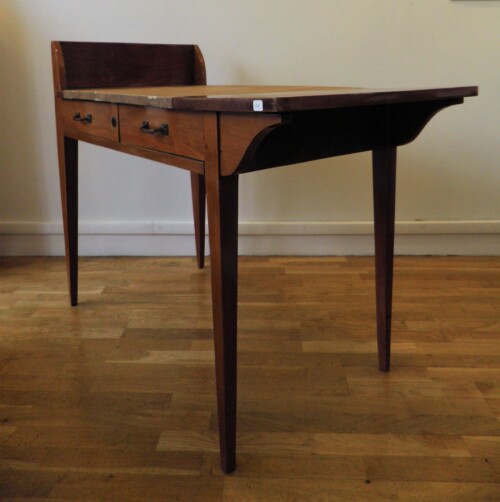
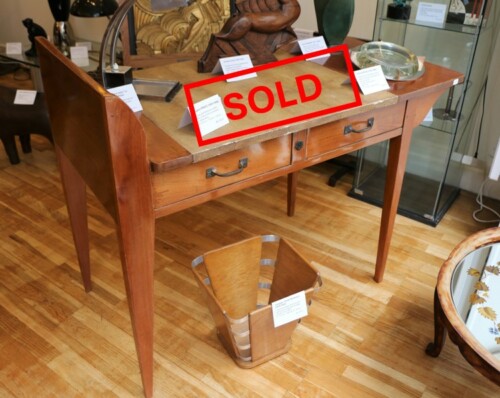 Eugène PRINTZ (1889-1948) Elégant bureau, dessiné par Printz pour la fameuse Cité Universitaire Internationale de Paris, de forme asymétrique, en acajou verni, ouvrant en façade par deux tiroirs. Les poignées sont en métal patiné et les plateau est recouvert d'un revêtement imitant le galuchat. Le bureau est dans son état original, et n'a jamais été restauré. La clef des tiroirs est manquante. Dans notre galerie se trouve aussi une étagère Printz destinée à la même résidence. 1930's H : 91 cm ; L : 113 cm ; P : 55 cm Pour plus d'informations sur le créateur, cliquer sur le nom : Eugène PRINTZ
Eugène PRINTZ (1889-1948) Elégant bureau, dessiné par Printz pour la fameuse Cité Universitaire Internationale de Paris, de forme asymétrique, en acajou verni, ouvrant en façade par deux tiroirs. Les poignées sont en métal patiné et les plateau est recouvert d'un revêtement imitant le galuchat. Le bureau est dans son état original, et n'a jamais été restauré. La clef des tiroirs est manquante. Dans notre galerie se trouve aussi une étagère Printz destinée à la même résidence. 1930's H : 91 cm ; L : 113 cm ; P : 55 cm Pour plus d'informations sur le créateur, cliquer sur le nom : Eugène PRINTZ
Art Déco wooden desk, by Eugène Printz. This asymmetric desk was designed by Eugène Printz (1889-1948) for the famous Cité Universitaire Internationale de Paris (a unique place where multiple residences - one per country - for international students were developped in the 1930's). It is made of varnished mahogany, has 2 drawers with patinated metal handles and is partly covered with canvas with a shagreen pattern. It is in its original condition and has not been restored. The drawer key is missing. The gallery has also in stock a matching book shelf which was also designed by Printz for the same residence. Dimensions : H : 35.83 in. ; W : 44.49 in. ; D : 21.65 in. H : 91 cm ; W : 113 cm ; D : 55 cm For more information : Eugène PRINTZ -
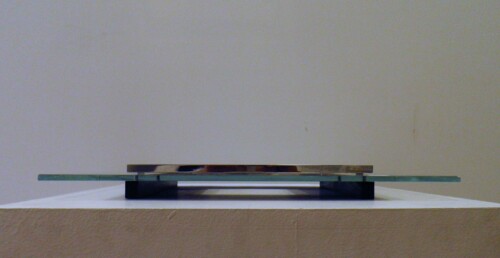
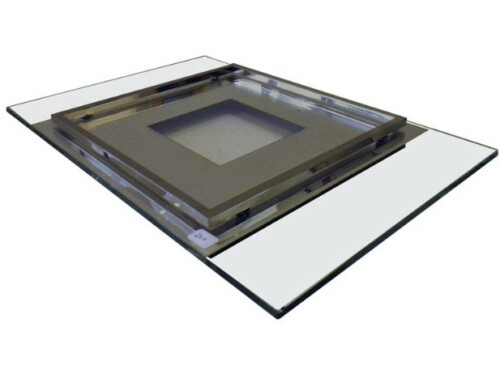 Boris LACROIX (1902-1984) Plateau en verre, bois noirci et métal. 1930's Dimensions : H : 3 cm; L : 48 cm; l : 33 cm; Pour plus d'informations sur le créateur, cliquer sur le nom : Boris LACROIX
Boris LACROIX (1902-1984) Plateau en verre, bois noirci et métal. 1930's Dimensions : H : 3 cm; L : 48 cm; l : 33 cm; Pour plus d'informations sur le créateur, cliquer sur le nom : Boris LACROIX
Glass tray, by Boris LACROIX (1902-1984) This glass tray can be used as a table centre piece. It was designed by Boris Lacroix in the 1930's and is a very fine example of the French Modernist style. Boris Lacroix was a famous Modernist designer alongside J. Adnet or R. Mallet-Stevens. It is made of glass partly treated as a mirror, blackened wood and nickel plated metal. Dimensions : H : 1.18 in.; W : 18.90 in.; D : 12.99 in. H : 3 cm; W : 48 cm; D : 33 cmFor more information : Boris LACROIX -
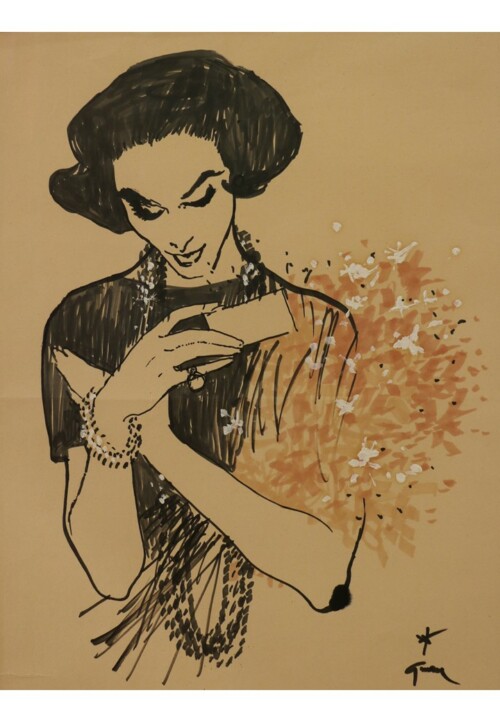
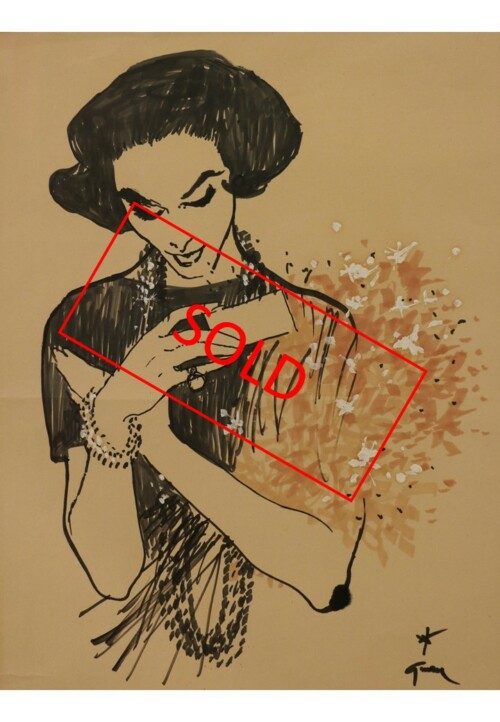 René GRUAU (1909-2004) Encre et aquarelle sur papier et rehauts de blanc, représentant une femme recevant un bouquet. Annoté "Mademoiselle Blanche - 8 centimètres, baguette dorée." Signé en bas à droite. Vers 1957 Dimensions (sans cadre) : H : 51 cm ; L : 36 cm Dimensions (avec cadre) : H : 63 cm ; L : 53,5 cm Pour plus d'informations sur le créateur, cliquer sur le nom : René GRUAU
René GRUAU (1909-2004) Encre et aquarelle sur papier et rehauts de blanc, représentant une femme recevant un bouquet. Annoté "Mademoiselle Blanche - 8 centimètres, baguette dorée." Signé en bas à droite. Vers 1957 Dimensions (sans cadre) : H : 51 cm ; L : 36 cm Dimensions (avec cadre) : H : 63 cm ; L : 53,5 cm Pour plus d'informations sur le créateur, cliquer sur le nom : René GRUAU
Drawing of a lady receiving a bouquet, by René GRUAU (1909-2004) Drawing by René Gruau (1909-2004) showing a lady receiving a bunch of flowers. Ink and watercolor on paper. Signed bottom right. The drawing is annotated "Mademoiselle Blanche - 8cm, baguette dorée" for framing instructions. The lady is probably Kouka, a famous model who was Gruau's muse. Dimensions (without frame) : H : 20.08 in.; W : 14.17 in. H : 51 cm ; L : 36 cm Dimensions (with frame) : H : 24.80 in.; W : 21.06 in. H : 63 cm ; L : 53,5 cm For more information : René GRUAU -
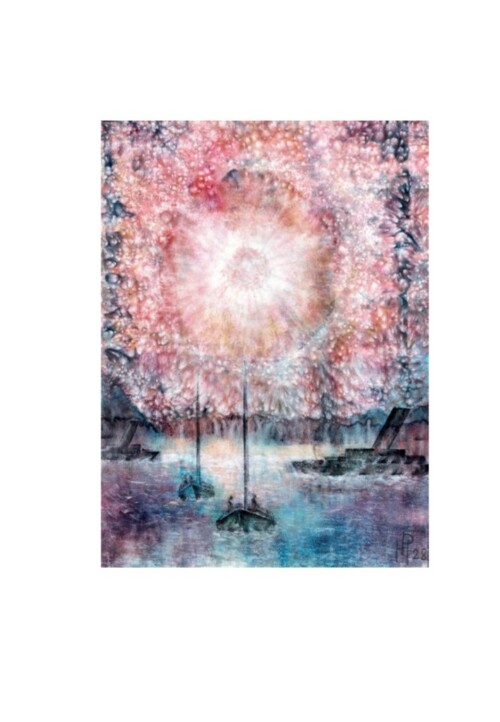 Henri Pfeiffer intègre le Bauhaus à l’âge de 17 ans, où il devient élève de Paul Klee. Il réalise de nombreuses œuvres abstraites avec une vision renouvelée de l’utilisation et de la perception des couleurs. Dès son plus jeune âge, Pfeiffer étudie intensivement la chimie des pigments sous la direction de son oncle. En 1933, lorsque le Bauhaus est interdit, il est arrêté par la Gestapo mais parvient à être libéré grâce à l’intervention de ses parents. Par la suite, il abandonne la peinture mais conserve une passion profonde pour les couleurs, devenant un ophtalmologue renommé, spécialisé dans la perception des couleurs. Après s’être installé en France, Pfeiffer écrit un livre sur le sujet dans les années 1950. Son parcours, de peintre avant-gardiste à scientifique obsédé toute sa vie par la compréhension de la perception des couleurs, est remarquable. Il suit les principes éthiques et philosophiques du Bauhaus, qui prônaient l’intégration de l’art, de la science et de l’industrie.
Henri Pfeiffer intègre le Bauhaus à l’âge de 17 ans, où il devient élève de Paul Klee. Il réalise de nombreuses œuvres abstraites avec une vision renouvelée de l’utilisation et de la perception des couleurs. Dès son plus jeune âge, Pfeiffer étudie intensivement la chimie des pigments sous la direction de son oncle. En 1933, lorsque le Bauhaus est interdit, il est arrêté par la Gestapo mais parvient à être libéré grâce à l’intervention de ses parents. Par la suite, il abandonne la peinture mais conserve une passion profonde pour les couleurs, devenant un ophtalmologue renommé, spécialisé dans la perception des couleurs. Après s’être installé en France, Pfeiffer écrit un livre sur le sujet dans les années 1950. Son parcours, de peintre avant-gardiste à scientifique obsédé toute sa vie par la compréhension de la perception des couleurs, est remarquable. Il suit les principes éthiques et philosophiques du Bauhaus, qui prônaient l’intégration de l’art, de la science et de l’industrie.- Aquarelle et pastel sur papier.
- Monogrammé "HP" et daté (19)28 dans le coin inférieur droit.
- Accompagné d'un message manuscrit au dos écrit par Pfeiffer lui-même : « Cette aquarelle signée HP 28 est originale de mon époque Bauhaus », signé « Ancien élève de Paul Klee ».
Henri Pfeiffer joined the Bauhaus at the age of 17, where he became a student of Paul Klee. He created numerous abstract works with a renewed vision of color use and perception. From a young age, Pfeiffer studied the chemistry of pigments intensively under the guidance of his uncle. In 1933, when the Bauhaus was banned, he was arrested by the Gestapo but was successfully released thanks to the intervention of his parents. After this, he abandoned painting but remained deeply passionate about color, eventually becoming a renowned ophthalmologist specializing in color perception. After moving to France, Pfeiffer wrote a book on the subject in the 1950s. His journey, from avant-garde painter to scientist with a lifelong obsession with color perception, is a remarkable story. It is in line with the ethical and philosophical principles of Bauhaus, which emphasized the integration of art, science, and industry.- Watercolor and pastel on paper.
- Monogrammed HP and dated (19)28 in the bottom right corner.
- Comes with a message on the back written by Pfeiffer himself : "Cette aquarelle signée HP 28 est originale de mon époque Bauhaus" ie "This watercolor signed HP 28 is original and dates back to my time at the Bauhaus", signed "Ancien élève de Paul Klee" ie "Former student of Paul Klee".
H : 46 cm L : 33,5 cm/ H : 18.1 in W : 13.2 in (without frame) H : 61 cm L : 49,3 cm/H : 24 in L : 19.4 in (with frame)For more information : Henri PFEIFFER
-
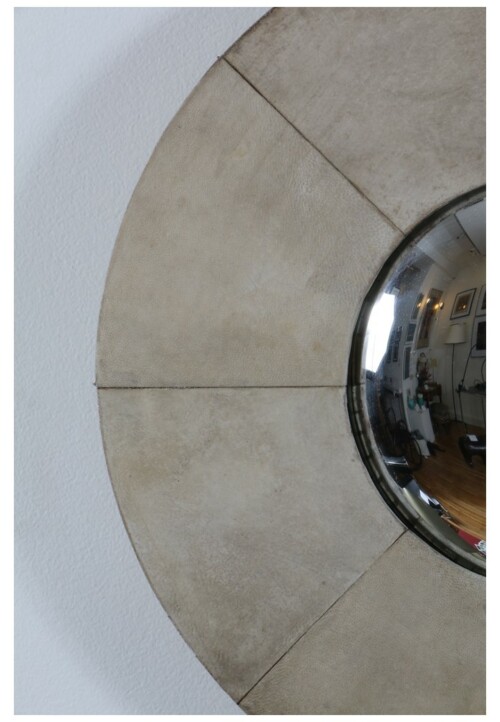
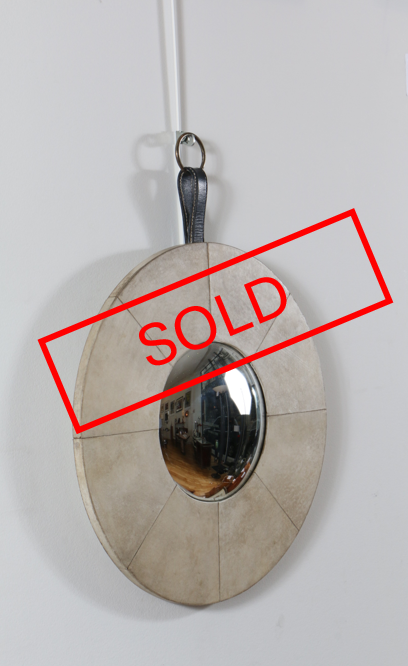 Jacques ADNET (1900 - 1984) Miroir sorcière gainé de parchemin blanc à accroche en cuir noir piqué cellier composé d'un anneau en laiton doré Vers 1940-1950 Hauteur : 57 cm ; Diamètre : 45 cm Pour plus d'informations sur le créateur, cliquer sur le nom : Jacques ADNET
Jacques ADNET (1900 - 1984) Miroir sorcière gainé de parchemin blanc à accroche en cuir noir piqué cellier composé d'un anneau en laiton doré Vers 1940-1950 Hauteur : 57 cm ; Diamètre : 45 cm Pour plus d'informations sur le créateur, cliquer sur le nom : Jacques ADNET
Eccentric Mirror Covered with Parchment by Jacque Adnet, 1940-1950.
Eccentric Mirror (also known as Convex Mirror or Witch Mirror - "Miroir de Sorcière") by Jacques Adnet (1900-1984).
Wood covered with white parchment, Convex mirror, Stitched leather and brass ring.
Very good condition. Period: 1940/1950.
H : 22.44 in. (57 cm) ; Diameter : 17.71 in. (45 cm) For more information : Jacques ADNET -
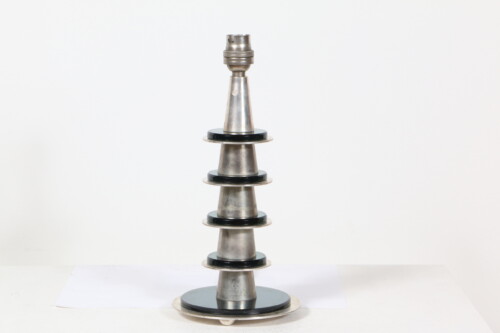
 Maison Desny, Clément NAUNY dit Lampe de bureau conique en bronze nickelé et composée de disques de verre teinté vert Cachet "Desny Paris Made in France déposé" Vers 1930 H : 28 cm ; Diamètre : 10 cm
Maison Desny, Clément NAUNY dit Lampe de bureau conique en bronze nickelé et composée de disques de verre teinté vert Cachet "Desny Paris Made in France déposé" Vers 1930 H : 28 cm ; Diamètre : 10 cm
A Modernist table lamp by Maison Desny, Art Deco, circa 1930. A Modernist/Art Deco Table Lamp by Maison Desny. Nickel plated bronze and dark green glass disks. Stamp "Desny Paris Made in France déposé" under the base. Circa 1930. Very good condition. Maison Desny was a famous modernist luxury design workshop created by Clément Nauny which operated in the late 1920's/early 1930's. Lamps were among their best selling pieces. Wired for European use (period wiring - which will have to be replaced for safety reason- with bakelite switch and socket). H : 11.02 in. (28 cm) Diameter : 3.94 in. (10 cm)
